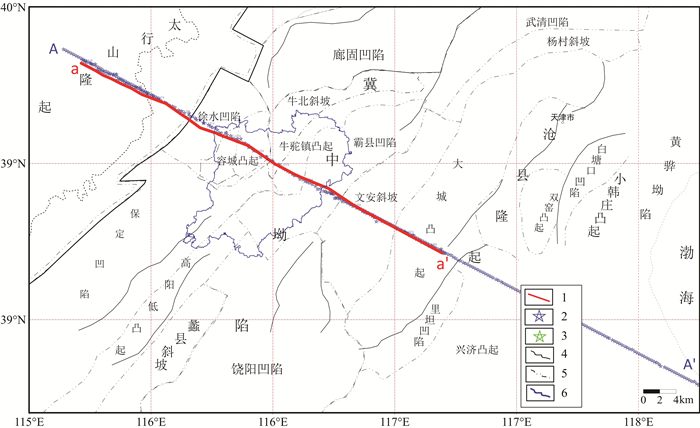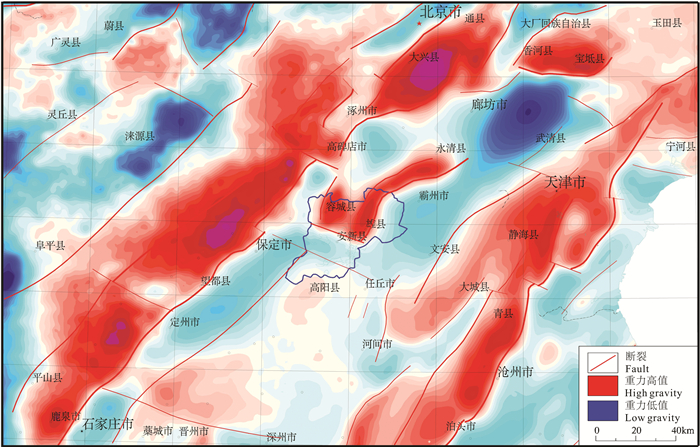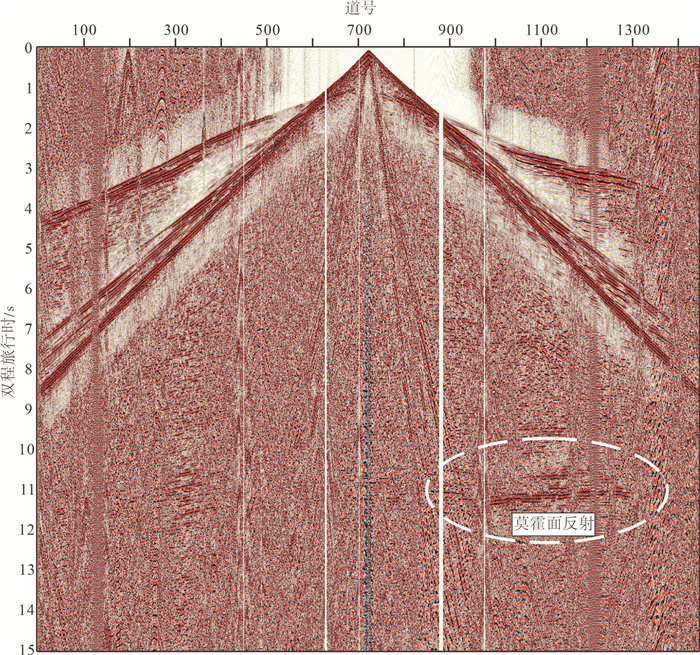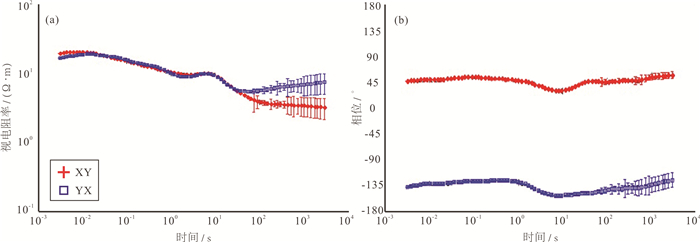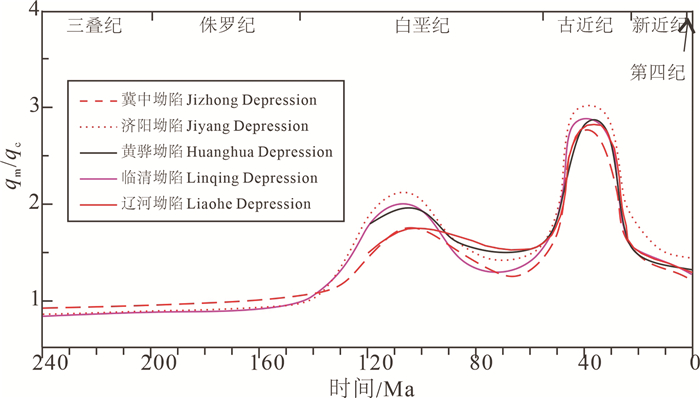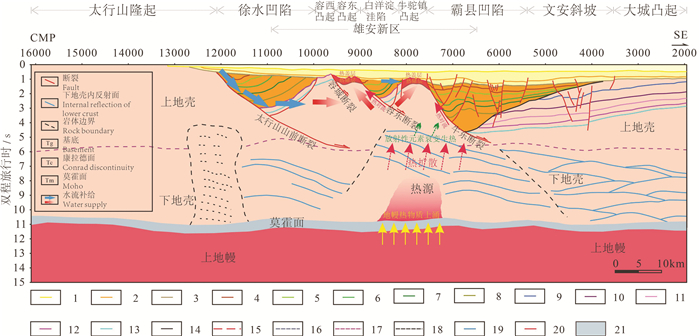-
摘要:
雄安新区内地热资源丰富,区内有牛驼镇地热田、容城地热田和高阳地热田,地热资源开发利用较早,但是对其深部热源机制仍未形成统一观点。为了研究雄安新区内地热田深部热源机制,在新区及外围进行了深反射地震和长周期大地电磁探测,对取得的同剖面的深反射地震和大地电磁数据进行处理和综合解释,探明了研究区从地表至莫霍面范围内地质构造和电性结构。下地壳结构在深反射地震剖面与大地电磁剖面上有很好的对应关系。电阻率低值区对应着在深反射地震剖面上存在一系列反射同相轴,且同相轴可以延续到莫霍面,电阻率高值区对应着在深反射地震剖面上无明显连续反射同相轴,尤其是在莫霍面之上呈现地震反射近似"空白区"。结合区域地热资料构建了研究区深部地热地质模型,对新区内深部地热机制进行了解释。该模型为"二元"生热模型,其热源包含两个部分,深部地幔热源和地壳放射性元素衰变生热。放射性元素衰变生热占地表热流的接近30%,而幔源热流在地表热流中的占比可达约70%。在牛驼镇下方,莫霍面以上,由于地幔热物质上涌造成下地壳上隆,幔源岩浆底侵作用于下地壳形成了局部热异常,该热异常具有低速高导的地球物理特征,认为是牛驼镇地热田和容城地热田的深部热源;以区域断裂为热通道,大地热流由深部向上传导、扩散到牛驼镇凸起和容城凸起顶部,对碳酸盐岩储水层进行加热,形成地热储层;上覆新近系沉积地层是良好的热盖层。
Abstract:Geothermal resources are abundant in the Xiong'an New Area, including Niutuozhen geothermal field, Rongcheng geothermal field and Gaoyang geothermal field. The geothermal resources in this area were developed and utilized earlier, but there is still no unified view on its deep heat source mechanism. In order to study the deep heat source mechanism, deep reflection seismic and long-period magnetotelluric survey were carried out in Xiong'an New Area and its periphery. The deep reflection seismic data and magnetotelluric data of the same section were processed and jointly interpreted. The geological structure and electrical structure in the study area from the surface to the Moho surface were explored. The lower crustal structure has a good corresponding relationship between the deep reflection seismic profile and the magnetotelluric profile. The area of low resistivity corresponds to the existence of a series of reflection events on the deep reflection seismic profile, and the event axis can continue to the Moho surface. The areas of high resistivity correspond to the absence of obvious continuous reflection events on the deep reflection seismic profile. Especially above the Moho surface, there is an approximate "blank area" of seismic reflection. Combined with regional geothermal data, a deep geothermal geological model of the study area was constructed, and the deep geothermal mechanism in the new area was explained. This model is a "dual" heat generation model, and its heat source consists of two parts, the deep mantle heat source and the heat generated by the decay of radioactive elements in the crust. The decay heat of radioactive elements accounts for nearly 30% of the surface heat flow, and the mantle-derived heat flow accounts for about 70% of the surface heat flow. Below Niutuo Town and above the Moho, the lower crust was uplifted due to the upwelling of hot mantle material, and the undercut of mantle-derived magma formed a local thermal anomaly in the lower crust. This thermal anomaly has low-speed and high-conductivity geophysical characteristics. It is considered to be the deep heat source of the Niutuozhen geothermal field and the Rongcheng geothermal field. With regional faults as the heat channel, the terrestrial heat flow is conducted upward from depth and diffused to the top of the Niutuozhen and Rongcheng bulges, which is a source of carbonate reservoirs. The water layer is heated to form a geothermal reservoir; the overlying Neogene sedimentary stratum is a good thermal cap layer.
-
1. 研究目的(Objective)
松科二井,获取了从基底—火石岭组—沙河子组—营城组—登娄库组下部连续完整的原位岩心。本文对松科二井沙河子组上部的孢粉化石进行研究,为研究白垩纪地球温室气候和环境变化,建立服务“百年大庆”目标和基础地质研究的“金柱子”提供基础资料。
2. 研究方法(Methods)
孢粉样品采自松科二井3395.46~3901.35 m,岩性为黑色、灰黑色泥岩、粉砂质泥岩,层位为沙河子组上部。孢粉分析鉴定在吉林大学古生物学与地层学研究中心完成,具体过程为:每个样品取过筛的干样50 g,进行盐酸→氢氟酸→氢氧化钾→盐酸→硝酸→氢氧化钾→盐酸等分析处理,用筛选法将样品中的孢粉化石集中在试管中,制2个固定片在生物显微镜下鉴定。
3. 研究结果(Results)
依据松科二井3395.46~3901.35 m井段的孢粉化石演化特征,划分出两个孢粉组合。
(1)Leiotriletes sp.- Cyathidites australis - Chasmatosporites sp.组合(简称LCC组合),分布在3832.94~3901.35m井段。蕨类孢子占绝对优势,裸子类花粉较低,未见被子类花粉。蕨类孢子含量最高的是Cyathidites australis,其次是Leiotriletes sp.和Cyclogranisporites sp.,有时代意义的还有Cicatricosisporites exilis、C. minutaestriatus、C. splendidus、C.australiensis、Klukisporites sp.、Maculatisporites sp.、Triporoletes singularis、Trilobosporites tribotrys、Aequitriradites sp.和Polycingulatisporites reduncus等;裸子类花粉含量最高的是Chasmatosporites sp.,其次是Psophosphaera sp.,有时代意义的类型有Parvisaccites sp.、Erlianpollis minisculus、Paleoconifersp.、Pseudowalchia sp.和Classopollis sp.等。
(2)Klukisporites triangulus- Aequitriradites sp.- Pristinuspollenites sp.组合(简称KAP组合),分布在3395.46~3613.62 m井段。裸子类花粉百分含量(53.03%~72.13%)较高,其次为蕨类孢子(27.87% ~46.97%),未见到被子类花粉。裸子类花粉中含量最高的是Alisporites parvus,其次是Piceaepollenites sp.,含量较高的类型还有Chasmatosporites sp.、Pinuspollenites divulgatus和P. sp.等,有时代意义的还有Parvisaccites otagoensis、Erlianpollis minisculus、E. mediocris、Jiaohepollis sp.和Classopollis classoides等。蕨类孢子含量最高的是Klukisporites sp.,其次是Leiotriletes sp.和Cyathidites australis,含量较高的类型还有Cyclogranisporites sp.等,有时代意义的有Cicatricosisporites exilis、C.apiteretus、C. australiensis、Klukisporites triangulus、K.variegatus、Pilosisporites scitulus、Impardecispora sp.、Levisporites wulinensis、Triporoletes singularis、Trilobosporites humilis、Aequitriradites sp.和Schizaeoisporites sp.等。
含有早白垩世特有或在早白垩世繁盛的分子:Cicatricosisporites、Klukisporites、Pilosisporites、Maculatisporites、Impardecispora、Levisporites、Triporoletes、Trilobosporites、Aequitriradites、Schizaeoisporites、Polycingulatisporites、Parvisaccites、Paleoconiferus、Erlianpollis、Foveotriletes.和Classopollis等(图 1)。
![]() 图 1 松科二井沙河子组部分孢粉化石(1-Cicatricosisporites exilis,样品号:SK2-375;2. -Cicatricosisporites minutaestriatus,标品号:SK2-385;3-Cicatricosisporites splendidus,标品号:SK2-385;4-Cicatricosisporites australiensis,样品号(sample number):SK2-375;5-Levisporites wulinensis,样品号(sample number):SK2-205;6. Aequitriradites sp.,样品号(sample number):SK2-389; 7-Trilobosporites tribotrys,样品号(sample number):SK2-389;8- Classopollis classoides,标品号:SK2-97;9-Erlianpollis minisculus,样品号(number):SK2-395; 10. Parvisaccites sp.,样品号:SK2-395;11. Pilosisporites scitulus,标品号:SK2-201;12-Triporoletes asper,标品号(specimen number):SK2-219;13. Foveotriletes subtriangulularis,样品号:SK2-219;14-Klukisporites triangulus,样品号(sample number):SK2-205;15-Impardecispora sp.,样品号:SK2-201; 16-Schizaeoisporites polaris,样品号:SK2-173;17-Polycingulatisporites reduncus,标品号:SK2-395;18-Maculatisporites sp.,样品号:SK2-391。19-Chasmatosporites sp.,样品号:SK2-389; 20-Paleoconiferae sp.,样品号(sample number):SK2-391;线段比例尺为10 μm, the scale of the line segment is 10 μm)Figure 1. Spores and pollen from the Lower Cretaceous Shahezi Formation in Well SK2
图 1 松科二井沙河子组部分孢粉化石(1-Cicatricosisporites exilis,样品号:SK2-375;2. -Cicatricosisporites minutaestriatus,标品号:SK2-385;3-Cicatricosisporites splendidus,标品号:SK2-385;4-Cicatricosisporites australiensis,样品号(sample number):SK2-375;5-Levisporites wulinensis,样品号(sample number):SK2-205;6. Aequitriradites sp.,样品号(sample number):SK2-389; 7-Trilobosporites tribotrys,样品号(sample number):SK2-389;8- Classopollis classoides,标品号:SK2-97;9-Erlianpollis minisculus,样品号(number):SK2-395; 10. Parvisaccites sp.,样品号:SK2-395;11. Pilosisporites scitulus,标品号:SK2-201;12-Triporoletes asper,标品号(specimen number):SK2-219;13. Foveotriletes subtriangulularis,样品号:SK2-219;14-Klukisporites triangulus,样品号(sample number):SK2-205;15-Impardecispora sp.,样品号:SK2-201; 16-Schizaeoisporites polaris,样品号:SK2-173;17-Polycingulatisporites reduncus,标品号:SK2-395;18-Maculatisporites sp.,样品号:SK2-391。19-Chasmatosporites sp.,样品号:SK2-389; 20-Paleoconiferae sp.,样品号(sample number):SK2-391;线段比例尺为10 μm, the scale of the line segment is 10 μm)Figure 1. Spores and pollen from the Lower Cretaceous Shahezi Formation in Well SK2上述2个孢粉组合分布在,属沙河子组上部,LCC组合蕨类孢子百分含量占绝对优势,裸子类花粉较少,从组合特点来看,可以与高瑞琪等人建立的沙河子组上部Granulatisporites-Lophotriletes-Cicatricosisporites组合大致对比,但上部的KAP组合层位显然高于高瑞琪等人建立的孢粉组合。与高瑞琪等人建立的孢粉组合相比,当前孢粉组合出现的有时代意义的孢粉类型更多且时代更新。
4. 结论(Conclusions)
两个孢粉组合海金砂科孢子繁盛,类型多样化,没有发现早期被子植物花粉;虽在蕨类孢子与裸子类花粉的百分含量及属种构成上明显不同,但出现的有时代意义的化石类型基本相同,其时代均为早白垩世早期。
5. 致谢(Acknowledgement)
本文为国家自然科学基金项目(41790451)和中国地质调查局项目(DD20190097)共同资助。孢粉化石由张淑琴研究员鉴定。
致谢: 在深反射地震数据采集中中石化石油工程地球物理有限公司江汉分公司给予了帮助,文稿修改过程中审稿专家提出了宝贵的修改意见,在此表示衷心的感谢! -
图 1 雄安新区综合地球物理测线位置图
1—易县—大城深反射地震剖面; 2—宽频大地电磁测点; 3—超长周期大地电磁测点; 4—断裂; 5—构造边界; 6—雄安新区边界
Figure 1. Location of geophysical survey lines of Xiong'an New Area and its periphery
1-Deep reflection seismic profile of Yixian-Dacheng; 2-Survey point of broadband magnetotelluric; 3-Survey point of ultra long period magnetotelluric; 4-Fault; 5-Tectonic boundary; 6-Boundary of Xiong'an New Area
图 6 深反射地震时间域(a)和深度域(b)偏移剖面及浅部地层解释
F1—太行山山前断裂;F2—容东断裂;F3—牛东断裂;1—第四系底界面;2—明化镇组底界面;3—馆陶组底界面;4—东营组底界面;5—沙河街组一段底界面;6—沙河街组二段底界面;7—沙河街组三段底界面;8—沙河街组四段底界面;9—中生界底界面;10—二叠—石炭系底界面;11—奥陶—寒武系底界面;12—新元古界顶界面;13—古元古界顶界面;14—不整合面;15—断裂;16—莫霍面
Figure 6. Deep reflection seismic profile in time-domain (a) and depth-domain (b), with the interpretation in shallow subsurface
F1-Taihang piedmont fault; F2-Rongdong fault; F3-Niudong fault; 1-Bottom of Quaternary; 2-Bottom of Minghuazhen Formation; 3-Bottom of Guantao Formation; 4-Bottom of Dongying Formation; 5-Bottom of Section 1 of Shahejie Formation; 6-Bottom of Section 2 of Shahejie Formation; 7-Bottom of Section 3 of Shahejie Formation; 8-Bottom of Section 4 of Shahejie Formation; 9-Bottom of Mesozoic; 10-Bottom of Permian-Carboniferous; 11-Bottom of Ordovician-Cambrian; 12-Top of Neoproterozoic; 13-Top of Paleoproterozoic; 14-Unconformity; 15-Fault; 16-Moho
图 9 渤海湾盆地主要构造单元中—新生代岩石圈热结构演化图(据邱楠生等,2017修改)
qm表示地幔热流,qc表示地壳热流;地幔热流主要是地幔中热物质上涌散热,地壳热流主要是地壳中放射性元素衰变生热
Figure 9. Meso-Cenozoic evolution of lithospheric thermal structure of the Bohai Bay Basin (Modified from Qiu Nansheng et al., 2017)
qm-mantle heat flow, qc-crustal heat flow; The mantle heat flow is mainly caused by the upwelling of thermal materials in the mantle, and the crustal heat flow is mainly generated by the decay of radioactive elements in the crust
图 10 雄安新区深部地热地质模型
1—第四系底界面; 2—明化镇组底界面; 3—馆陶组底界面; 4—东营组底界面; 5—沙河街组一段底界面; 6—沙河街组二段底界面; 7—沙河街组三段底界面; 8—沙河街组四段底界面; 9—中生界底界面; 10—二叠—石炭系底界面; 11—奥陶—寒武系底界面; 12—新元古界顶界面; 13—古元古界顶界面; 14—不整合面; 15—深部热源边界; 16—结晶基底; 17—中下地壳分界面; 18—下地壳岩体边界; 19—下地壳叠层状反射; 20—断裂; 21—莫霍面
Figure 10. The geothermal geological model of Xiong'an New Area in the deep subsurface
1-Bottom of Quaternary; 2—Bottom of Minghuazhen Formation; 3-Bottom of Guantao Formation; 4-Bottom of Dongying Formation; 5-Bottom of Section 1 of Shahejie Formation; 6-Bottom of Section 2 of Shahejie Formation; 7-Bottom of Section 3 of Shahejie Formation; 8—Bottom of Section 4 of Shahejie Formation; 9-Bottom of Mesozoic; 10-Bottom of Permian-arboniferous; 11-Bottom of Ordovician-Cambrian; 12-Top of Neoproterozoic; 13-Top of Paleoproterozoic; 14-Unconformity; 15-Boundary of heat source; 16-Crystalline basement; 17-Interface between middle and lower crust; 18-Boundary of rock mass in lower crust; 19-Laminated reflection in lower crust; 20-Fault; 21-Moho
表 1 沿易县—大城深反射地震剖面的区域构造单元边界
Table 1 The Regional tectonic unit boundaries along the Yixian-Dacheng deep reflection seismic profile

表 2 雄安新区内不同构造单元地温梯度及大地热流(王朱亭等,2019)
Table 2 Geothermal heat flow value of different tectonic units in Xiong'an New Area (Wang et al., 2019)

表 3 牛驼镇凸起构造层厚度、岩石生热率及热导率(据常健,2016修改)
Table 3 Thicknesses, heat generations and conductivity of tectonic layers of Niutuozhen raised structural layer (Modified from Chang et al., 2016)

-
An Huiting, Xu Liqing, Li Sanzhong, Yu Shan, Liu Xin, Suo Yanhui, Cao Xianzhi, Zhao Shujuan, Wang Pengcheng, Guo Lingli, Dai Liming. 2015. Meso-Cenozoic stress fields and their transition mechanisms in the Eastern Taihang Mountain Fault Zone[J]. Geotectonica et Metallogenia, 39(4): 571-586 (in Chinese with English abstract). http://www.researchgate.net/publication/282936498_Meso-cenozoic_stress_fields_and_their_transition_mechanisms_in_the_Eastern_Taihang_Mountain_Fault
Cao Xianzhi, Li Sanzhong, Liu Xin, Suo Yanhui, Zhao Shujuan, Xu Liqing, Dai Liming, Wang Pengcheng, Yu Shan. 2013. The intraplate morphotectonic inversion along the Eastern Taihang Mountain Fault Zone, North China and its mechanism[J]. Earth Science Frontiers, 20(4): 88-103 (in Chinese with English abstract).
Chang Jian, Qiu Nansheng, Zhao Xianzheng, Xu Wei, Xu Qiuchen, Jin Fengming, Han Chunyuan, Ma Xuefeng, Dong Xiongying, Liang Xiaojuan. 2016. Present-day geothermal regime of the Jizhong depressionin Bohai Bay basin, East China[J]. Chinese J. Geophys., 59(3): 1003-1016 (in Chinese with English abstract). http://www.researchgate.net/profile/Jian_Chang5/publication/296488927_Present-day_geothermal_regime_of_the_Jizhong_Depression_in_Bohai_Bay_BasinEast_China/links/56d6400908aebe4638ac6f8f.pdf
Chen Moxiang, Huang Geshan, Zhang Wenren, Zhang Rongyan, Liu Bingyi. 1982. The temperature distribution pattern and the utilization of geothermal water at Niutuozhen basement protrusion of Central Hebei Province[J]. Scientia Geologica Sinica, (3): 239-252 (in Chinese with English abstract). http://www.researchgate.net/publication/316934004_The_temperature_distribution_pattern_and_the_utilization_of_geothermal_water_at_Niutuozhen_basement_protrusion_of_central_Hebei_Province_China
Chen Moxiang, Wang Jiyang, Wang Ji'an, Deng Xiao, Yang Shuzhen, Xiong Liangping, Zhang Juming. 1990. The characteristics of the geothermal field and its formation mechanism in the North China down-faulted basin[J]. Acta Geologica Sinica, 64(1): 80-91 (in Chinese with English abstract). http://en.cnki.com.cn/Article_en/CJFDTOTAL-DZXE199001007.htm
Gao Rui, Xiong Xiaosong, Li Qiusheng, Lu Zhanwu. 2009. The Moho depth of Qinghai-Tibet Plateau revealed by seismic detection[J]. Acta Geoscientica Sinica, 30(6): 761-773 (in Chinese with English abstract). http://www.researchgate.net/profile/Qiusheng_Li/publication/225161141_The_Moho_depth_of_Qinghai-Tibet_Plateau_revealed_by_seismic_detection/links/00b4952cbb2fc3f227000000.pdf
Guo Jingru, Jiang Duoyuan, Tang Wenbang, Zhao Wenjing 1996. Data acquisition of the first super-deep seismic profile in Qinghai Tibetan (Xizang) Plateau and the method of its processing[J]. Acta Geoscientica Sinica, 17(2): 202-213 (in Chinese with English abstract). http://en.cnki.com.cn/Article_en/CJFDTotal-DQXB602.011.htm
He Dengfa, Shan Shuaiqiang, Zhang Yuying, Lu Renqi, Zhang Ruifeng, Cui Yongqian 2018. 3-D geologic architecture of Xiong'an New Area: Constraints from seismic reflection data[J]. Scientia Sinica Terrae, 48(9): 1207-1222 (in Chinese with English abstract). doi: 10.1360/N072017-00345
Hu Qiuyun, Gao Jun, Ma Feng, Zhao Zhihong, Liu Guihong, Wang Guiling, Zhang Wei, Zhu Xi, Zhang Baojian, Xing Yifei. 2020. Dynamic prediction of geothermal recoverable resources in the Rongcheng uplift area of the Xiong'an New Area[J]. Acta Geologica Sinica, 94(7): 2013-2025 (in Chinese with English abstract).
Li Haitao, Feng Wei, Wang Kailin, Zhao Kai, Li Gang, Zhang Yuan, Li Muzi, Sun Lu, Chen Yichao, You Bing. 2021. Groundwater resources in Xiong'an New Area and its exploitation potential[J]. Geology in China, 48(4): 1112-1126 (in Chinese with English abstract).
Li Wenhui, Gao Rui, Wang Haiyan, Li Hongqiang. 2012. Research on structure information recognition of deep seismci reflection profiles[J]. Chinese Journal of Geophysics, 55(12): 4138-4146 (in Chinese with English abstract).
Liu J, Davis G A, Lin Z, Wu F. 2005. The Liaonan metamorphic core complex, Southeastern Liaoning Province, North China: A likely contributor to Cretaceous rotation of Eastern Liaoning, Korea and contiguous areas[J]. Tectonophysics, 407(1/2): 65-80. http://www.sciencedirect.com/science/article/pii/S0040195105003264
Liu Mingliang, He Tong, Wu Qifan, Guo Qinghai. 2019. Hydrogeochemistry of geothermal waters from the Xiong'an New Area and its indicating significance[J]. Earth Science, 45(6): 2221-2231 (in Chinese with English abstract).
Lu Zhanwu, Gao Rui, Li Qiusheng, He Rizheng, Kuang Chaoyang, Hou Hesheng, Xiong Xiaosong, Guan Ye, Wang Haiyan, Klemperer L S. 2009. Testing deep seismic reflection profiles across the central uplift of the Qiangtang terrane in the Tibetan Plateau[J]. Chinese Journal of Geophysics, 52(8): 2008-2014 (in Chinese with English abstract). http://en.cnki.com.cn/Article_en/CJFDTOTAL-DQWX200908009.htm
Lu Zhanwu, Gao Rui, Wang Haiyan, Li Wenhui, Li Hongqiang. 2014. Bright spots in deep seismic reflection profiles[J]. Progress in Geophysics, 29(6): 2518-2525 (in Chinese with English abstract). http://or.nsfc.gov.cn/handle/00001903-5/459675
Ma Feng, Wang Guiling, Zhang Wei, Zhu Xi, Zhang Hanxiong, Yue Gaofan. 2020. Structure of geothermal reservoirs and resource potential in the Rongcheng geothermal field in Xiong'an New Area[J]. Acta Geologica Sinica, 94(7): 1981-1990 (in Chinese with English abstract).
Marquis G, Hyndman R D. 1992. Geophysical support for aqueous fluids in the deep crust: Seismic and electrical relationships[J]. Geophys J. Int., 110(1): 91-105. doi: 10.1111/j.1365-246X.1992.tb00716.x
Ma Zhen, Xia Yubo, Li Haitao, Han Bo, Yu Xuezhong, Zhou Yalong, Wang Yushan, Guo Xu, Li Hongqiang, Pei Yandong. 2021. Analysis of natural resources and environment eco-geological conditions in the Xiong'an New Area[J]. Geology in China, 48(3): 677-696 (in Chinese with English abstract).
Niu Shuyin. 1994, Taihangshan Fuping Zanhuang uplift are Meso-Cenozoic metamorphic core complexes[J]. Geological Science and Technology Information, 13(2): 15-16 (in Chinese). http://en.cnki.com.cn/Article_en/CJFDTOTAL-HBDX199401004.htm
Pang Zhonghe, Kong Yanlong, Pang Jumei, Hu Shengbiao, Wang Jiyang. 2017. Geothermal resources and development in Xiong'an New Area[J]. Science & Technology Supporting Xiong'an New Area Planning and Construction, 32(11): 1224-1230 (in Chinese with English abstract). http://en.cnki.com.cn/Article_en/CJFDTOTAL-KYYX201711009.htm
Pang Z, Pang J, Kong Y, Luo L, Duan Z, Yang F, Wang S. 2015. Large Karstic Geothermal Reservoirs in Sedimentary Basins in China: Genesis, Energy Potential and Optimal Exploitation[M]. World Geothermal Congress 2015. Melbourne, Australia.
Qiu Nansheng, Xu Wei, Zuo Yinhui, Chang Jian, Liu Chunli. 2017. Evolution of Meso-Cenozoic thermal structure and thermal-geological structure of the lithosphere in the Bohai Bay Basin, Eastern North China Craton[J]. Earth Science Frontiers, 24(3): 13-26 (in Chinese with English abstract).
Rao Song, Hu Shengbiao, Zhu Chuanqing, Tang Xiaoyin, Li Weiwei, Wang Jiyang. 2013. The characteristics of heat flow and lithospheric thermal structure in Junggar Basin, northwest China[J]. Chinese Journal of Geophysics, 56(8): 2760-2770(in Chinese with English abstract). http://www.onacademic.com/detail/journal_1000039312598010_d459.html
Song Honglin 1996. Characteristics of Fangshan metamorphic core complex, Beijing and a discussion about its origin[J]. Geoscience, 10(2): 149-158 (in Chinese with English abstract). http://en.cnki.com.cn/Article_en/CJFDTOTAL-XDDZ602.001.htm
Sui Shaoqiang, Wang Xinwei, Zhou Zongying, Liu Jinxia, Mao Xiang. 2019. Study on the thermal reservoir characteristics of karst geothermal fields in Tianjin City[J]. Geology and Resources, 28(6): 590-594, 569 (in Chinese with English abstract).
Sun Dongsheng, Liu Chiyang, Yang Minghui, Du Jinhu, Zhang Yiming, Zhang Ruifeng. 2004. Evidences for the large-scale detachment structure in middle area of Jizhong depression in Mid-Late Mesozoic period[J]. Geotectonica et Metallogenia, 28(2): 126-133 (in Chinese with English abstract). http://epub.cnki.net/grid2008/docdown/docdownload.aspx?filename=DGYK200402002&dbcode=CJFD&year=2004&dflag=pdfdown
Sun Weijia, Fu Liyun, Wei Wei, Lin Yi, Tang Qingya. 2018. The crust-mantle transition structures beneath eastern China[J]. Chinese Journal of Geophysics, 61(3): 845-855 (in Chinese with English abstract). http://en.cnki.com.cn/Article_en/CJFDTOTAL-DQWX201803004.htm
Suo Yanhui, Li Sanzhong, Cao Xianzhi, Li Xiyao, Liu Xin, Cao Huahua. 2017. Mesozoic-Cenozoic inversion tectonics of East China and its implications for the subduction process of the oceanic plate[J]. Earth Science Frontiers, 24(4): 249-267 (in Chinese with English abstract). http://en.cnki.com.cn/Article_en/CJFDTOTAL-DXQY201704031.htm
Wang Chunyong, Zhang Xiankang, Wu Qingju, Zhu Zhiping. 1994. Seismic evidence of detachment in North China Basin[J]. Acta Geophysica Sinica, 37(5): 613-619 (in Chinese with English abstract). http://en.cnki.com.cn/Article_en/CJFDTOTAL-DQWX405.006.htm
Wang Guiling, Gao Jun, Zhang Baojian, Xing Yifei, Zhang Wei, Ma Feng 2020. Study on the thermal storage characteristics of the Wumishan Formation and huge capacity geothermal well parameters in the Gaoyang low uplift area of Xiong'an New Area[J]. Acta Geologica Sinica, 94(7): 1970-1980 (in Chinese with English abstract).
Wang Haiyan, Gao Rui, Lu Zhanwu, Li Qiusheng, Kuang Zhaoyang, Liu Jinkai, Hou Hesheng, Feng Shaoying, Xiong Xiaosong, Li Wenhui, Deng Gong. 2010. Fine structure of the continental lithosphere circle revealed by deep seismic reflection profile[J]. Acta Geologica Sinica, 84(6): 818-839 (in Chinese with English abstract). http://epub.cnki.net/grid2008/docdown/docdownload.aspx?filename=DZXE201006008&dbcode=CJFD&year=2010&dflag=pdfdown
Wang Ji'an. 1992. The Geothermal Characteristics and Oil and Gas Resources of Liaohe Fault Depression[C]//Bulletin of the Institute of Geology, Chinese Academy of Sciences(5). Beijing: Science Press, 1-77(in Chinese with English abstract).
Wang Jiyang, Hu Shengbiao, Pang Zhonghe, He Lijuan, Zhao Ping, Zhu Chuanqing, Rao Song, Tang Xiaoyin, Kong Yanlong, Luo Lu, Li Weiwei. 2012. Estimate of geothermal resources potential for hot dry rock in the continental area of China[J]. Science & Technology Review, 30(32): 25-31 (in Chinese with English abstract).
Wang Zhuting, Zhang Chao, Jiang Guangzheng, Hu Jie, Tang Xianchun, Hu Shengbiao. 2019. Present-day geothermal field of Xiong'an New Area and its heat source mechanism[J]. Chinese Journal of Geophysics, 62(11): 4313-4322 (in Chinese with English abstract). http://en.cnki.com.cn/Article_en/CJFDTotal-DQWX201911026.htm
Wei Wenbo, Jin Sheng, Ye Gaofeng, Deng Ming, Tan Handong, Martyn Unsworth, John Booker, Alan G Jones, Li Shenghui. 2006. Features of the faults in center and north Tibetan Plateau: Based on results of INDEPTH(Ⅲ)-MT[J]. Earth Science-Journal of China University of Geosciences, 31(2): 257-265 (in Chinese with English abstract).
Xu Tairan, Lu Zhanwu, Wang Haiyan, Li Hongqiang, Li Wenhui. 2017. Main technology of deep seismic reflection data processing[J]. Progress in Geophysics, 32(2): 762-774 (in Chinese with English abstract).
Xu Wenliang, Wang Qinghai, Wang Dongyan, Pei Fuping, Gao Shan. 2004. Processes and mechanism of Mesozoic lithospheric thinning in eastern North China Craton: Evidence from Mesozoic igneous rocks and deep-seated xenoliths[J]. Earth Science Frontiers, 11(3): 309-317 (in Chinese with English abstract). http://en.cnki.com.cn/Article_en/CJFDTOTAL-DXQY200403040.htm
Zhan Yan, Zhao Guoze, Wang Jijun, Xiao Qibin, Tang Ji, Rokityansky I I. 2006. Crustal electric conductivity structure for Wudalianchi volcanic cluster in the Heilongjiang Province, China[J]. Acta Petrologica Sinica, 22(6): 1494-1502 (in Chinese with English abstract). http://www.oalib.com/paper/1473010
Zhan Yan, Zhao Guoze, Wang Lifeng, Wang Jijun, Xiao Qibin. 2011. Deep structure in Shijiazhuang and the vicinity by magnetotellurics[J]. Seismology and Geology, 33(4): 913-927 (in Chinese with English abstract). http://en.cnki.com.cn/Article_en/CJFDTotal-DZDZ201104017.htm
Zhang Dongning, Zeng Rongsheng. 1995. Numerical simulation of decollement tectonic dynamics in Jizhong depression[J]. Acta Seismologica Sinica, 17(4): 414-421 (in Chinese with English abstract).
Zhao Jiayi, Zhang Wei, Ma Feng, Zhu Xi, Zhang Hanxiong, Wang Guiling. 2020. Geochemical characteristics of the geothermal fluid in the Rongcheng geothermal field, Xiong'an New Area[J]. Acta Geologica Sinica, 94(7): 1991-2001 (in Chinese with English abstract).
Zhu Guang, Hu Zhaoqi, Chen Yin, Niu Manlan, Xie Chenglong. 2008. Evolution of Early Cretaceous extensional basins in the eastern North China craton and its implication for the craton destruction[J]. Geological Bulletin of China, 27(10): 1594-1604 (in Chinese with English abstract). http://www.oalib.com/paper/1472948
Zhu Rixiang, Xu Yigang, Zhu Guang, Zhang Hongfu, Xia Qunke, Zheng Tianyu. 2012. Destruction of the North China Craton[J]. Science China (Earth Science), 42(8): 1135-1159 (in Chinese with English abstract).
Zhu Rixiang, Zheng Tianyu. 2009. Destruction geodynamics of the North China Craton and its Paleoproterozoic plate tectonics[J]. Chinese Sci. Bull., 54(14): 1950-1961 (in Chinese with English abstract). doi: 10.1360/csb2009-54-14-1950
Zhang Xuemin. 2005. Shear Wave Velocity Structures in Crust and Mantle of North China and Study on the Relationship with Geological Evolution since Late Cenozoic[D]. Beijing: China University of Geosciences (Beijing)(in Chinese with English abstract).
安慧婷, 许立青, 李三忠, 余珊, 刘鑫, 索艳慧, 曹现志, 赵淑娟, 王鹏程, 郭玲莉, 戴黎明. 2015. 太行山东麓断裂带中、新生代构造应力场及转换机制[J]. 大地构造与成矿学, 39(4): 571-586. https://www.cnki.com.cn/Article/CJFDTOTAL-DGYK201504002.htm 曹现志, 李三忠, 刘鑫, 索艳慧, 赵淑娟, 许立青, 戴黎明, 王鹏程, 余珊. 2013. 太行山东麓断裂带板内构造地貌反转与机制[J]. 地学前缘, 20(4): 88-103. https://www.cnki.com.cn/Article/CJFDTOTAL-DXQY201304010.htm 常健, 邱楠生, 赵贤正, 许威, 徐秋晨, 金凤鸣, 韩春元, 马学峰, 董雄英, 梁小娟. 2016. 渤海湾盆地冀中坳陷现今地热特征[J]. 地球物理学报, 59(3): 1003-1016. https://www.cnki.com.cn/Article/CJFDTOTAL-DQWX201603022.htm 陈墨香, 黄歌山, 张文仁, 张容燕, 刘炳义. 1982. 冀中牛驼镇凸起地温场的特点及地下热水的开发利用[J]. 地质科学, (3): 239-252. https://www.cnki.com.cn/Article/CJFDTOTAL-DZKX198203000.htm 陈墨香, 汪集旸, 汪缉安, 邓孝, 杨淑贞, 熊亮平, 张菊明1990. 华北断陷盆地热场特征及其形成机制[J]. 地质学报, 64(1): 80-91. https://www.cnki.com.cn/Article/CJFDTOTAL-DZXE199001007.htm 高锐, 熊小松, 李秋生, 卢占武. 2009. 由地震探测揭示的青藏高原莫霍面深度[J]. 地球学报, 30(6): 761-773. doi: 10.3321/j.issn:1006-3021.2009.06.008 郭景如, 蒋多元, 唐文榜, 赵文津. 1996. 青藏高原第一条超深反射地震剖面的数据采集及其处理方法[J]. 地球学报, 17(2): 202-213. https://www.cnki.com.cn/Article/CJFDTOTAL-DQXB602.011.htm 何登发, 单帅强, 张煜颖, 鲁人齐, 张锐锋, 崔永谦. 2018. 雄安新区的三维地质结构: 来自反射地震资料的约束[J]. 中国科学: 地球科学, 48(9): 1207-1222. https://www.cnki.com.cn/Article/CJFDTOTAL-JDXK201809007.htm 胡秋韵, 高俊, 马峰, 赵志宏, 刘桂宏, 王贵玲, 张薇, 朱喜, 张保建, 邢一飞. 2020. 雄安新区容城凸起地区地热可采资源量动态预测[J]. 地质学报, 94(7): 2013-2025. doi: 10.3969/j.issn.0001-5717.2020.07.010 李海涛, 凤蔚, 王凯霖, 赵凯, 李刚, 张源, 李木子, 孙璐, 陈一超, 尤冰. 2021. 雄安新区地下水资源概况、特征及可开采潜力[J]. 中国地质, 48(4): 1112-1126. http://geochina.cgs.gov.cn/geochina/ch/reader/view_abstract.aspx?file_no=20210409&flag=1 李文辉, 高锐, 王海燕, 李洪强. 2012. 深地震反射剖面构造信息识别研究[J]. 地球物理学报, 55(12): 4138-4146. doi: 10.6038/j.issn.0001-5733.2012.12.026 刘明亮, 何曈, 吴启帆, 郭清海. 2019. 雄安新区地热水化学特征及其指示意义[J]. 地球科学, 45(6): 2221-2231 https://www.cnki.com.cn/Article/CJFDTOTAL-DQKX202006032.htm 卢占武, 高锐, 李秋生, 贺日政, 匡朝阳, 侯贺晟, 熊小松, 管烨, 王海燕, Klemperer L S. 2009. 横过青藏高原羌塘地体中央隆起区的深反射地震试验剖面[J]. 地球物理学报, 52(8): 2008-2014. doi: 10.3969/j.issn.0001-5733.2009.08.008 卢占武, 高锐, 王海燕, 李文辉, 李洪强. 2014. 深地震反射剖面上的"亮点"构造[J]. 地球物理学进展, 29(6): 2518-2525. https://www.cnki.com.cn/Article/CJFDTOTAL-DQWJ201406006.htm 马峰, 王贵玲, 张薇, 朱喜, 张汉雄, 岳高凡. 2020. 雄安新区容城地热田热储空间结构及资源潜力[J]. 地质学报, 94(7): 1981-1990. doi: 10.3969/j.issn.0001-5717.2020.07.007 马震, 夏雨波, 李海涛, 韩博, 余学中, 周亚龙, 王雨山, 郭旭, 李洪强, 裴艳东. 2021. 雄安新区自然资源与环境-生态地质条件分析[J]. 中国地质, 48(3): 677-696. http://geochina.cgs.gov.cn/geochina/ch/reader/view_abstract.aspx?file_no=20210301&flag=1 牛树银. 1994. 太行山阜平、赞皇隆起是中新生代变质核杂岩[J]. 地质科技情报, 13(2): 15-16. https://www.cnki.com.cn/Article/CJFDTOTAL-DZKQ402.004.htm 庞忠和, 孔彦龙, 庞菊梅, 胡圣标, 汪集暘. 2017. 雄安新区地热资源与开发利用研究[J]. 中国科学院院刊, 32(11): 1224-1230. https://www.cnki.com.cn/Article/CJFDTOTAL-KYYX201711009.htm 邱楠生, 许威, 左银辉, 常健, 刘春黎. 2017. 渤海湾盆地中-新生代岩石圈热结构与热-流变学演化[J]. 地学前缘(中国地质大学(北京); 北京大学, 24(3): 013-026. https://www.cnki.com.cn/Article/CJFDTOTAL-DXQY201703003.htm 饶松, 胡圣标, 朱传庆, 唐晓音, 李卫卫, 汪集旸. 2013. 准噶尔盆地大地热流特征与岩石圈热结构[J]. 地球物理学报, 56(8): 2760-2770. https://www.cnki.com.cn/Article/CJFDTOTAL-DQWX201308025.htm 宋鸿林. 1996. 北京房山变质核杂岩的基本特征及其成因探讨[J]. 现代地质, (2): 149-158. https://www.cnki.com.cn/Article/CJFDTOTAL-XDDZ602.001.htm 隋少强, 汪新伟, 周总瑛, 刘金侠, 毛翔. 2019. 天津岩溶地热田热储特征研究[J]. 地质与资源, 28(6): 590-594, 569. doi: 10.3969/j.issn.1671-1947.2019.06.011 孙冬胜, 刘池阳, 杨明慧, 杜金虎, 张以明, 张锐锋. 2004. 冀中坳陷中区中生代中晚期大型拆离滑覆构造的确定[J]. 大地构造与成矿学, (2): 126-133. doi: 10.3969/j.issn.1001-1552.2004.02.003 孙伟家, 符力耘, 魏伟, 林羿, 唐清雅. 2018. 中国东部地区的壳-幔过渡带结构[J]. 地球物理学报, 61(3): 845-855. https://www.cnki.com.cn/Article/CJFDTOTAL-DQWX201803004.htm 索艳慧, 李三忠, 曹现志, 李玺瑶, 刘鑫, 曹花花. 2017. 中国东部中新生代反转构造及其记录的大洋板块俯冲过程[J]. 地学前缘, 24(4): 249-267. https://www.cnki.com.cn/Article/CJFDTOTAL-DXQY201704031.htm 汪缉安. 1992. 辽河断陷地热特征与油气资源[C]//中国科学院地质研究所集刊(5). 北京: 科学出版社, 1-77. 汪集旸, 胡圣标, 庞忠和, 何丽娟, 赵平, 朱传庆, 饶松, 唐晓音, 孔彦龙, 罗璐, 李卫卫. 2012. 中国大陆干热岩地热资源潜力评估[J]. 科技导报, 30(32): 25-31. doi: 10.3981/j.issn.1000-7857.2012.32.002 王椿镛, 张先康, 吴庆举, 祝治平. 1994. 华北盆地滑脱构造的地震学证据[J]. 地球物理学报, 37(5): 613-619. doi: 10.3321/j.issn:0001-5733.1994.05.007 王贵玲, 高俊, 张保建, 邢一飞, 张薇, 马峰. 2020. 雄安新区高阳低凸起区雾迷山组热储特征与高产能地热井参数研究[J]. 地质学报, 94(7): 1970-1980. doi: 10.3969/j.issn.0001-5717.2020.07.006 王海燕, 高锐, 卢占武, 李秋生, 匡朝阳, 刘金凯, 侯贺晟, 酆少英, 熊小松, 李文辉, 邓攻. 2010. 深地震反射剖面揭露大陆岩石圈精细结构[J]. 地质学报, 84(6): 818-839. doi: 10.3969/j.issn.1004-9665.2010.06.002 王朱亭, 张超, 姜光政, 胡杰, 唐显春, 胡圣标. 2019. 雄安新区现今地温场特征及成因机制[J]. 地球物理学报, 62(11): 4313-4322. doi: 10.6038/cjg2019M0326 魏文博, 金胜, 叶高峰, 邓明, 谭捍东, Martyn, Unsworth, John, Booker, Aian. 2006. 西藏高原中、北部断裂构造特征: INDEPTH(Ⅲ)-MT观测提供的依据[J]. 地球科学, 31(2): 257-265. doi: 10.3321/j.issn:1000-2383.2006.02.017 徐泰然, 卢占武, 王海燕, 李洪强, 李文辉. 2017. 深反射地震剖面数据处理的主要技术方法[J]. 地球物理学进展, 32(2): 762-774. https://www.cnki.com.cn/Article/CJFDTOTAL-DQWJ201702042.htm 许文良, 王清海, 王冬艳, 裴福萍, 高山. 2004. 华北克拉通东部中生代岩石圈减薄的过程与机制: 中生代火成岩和深源捕虏体证据[J]. 地学前缘, 11(3): 309-317. doi: 10.3321/j.issn:1005-2321.2004.03.029 詹艳, 赵国泽, 王继军, 肖骑彬, 汤吉, II R. 2006. 黑龙江五大连池火山群地壳电性结构[J]. 岩石学报, 22(6): 1494-1502. https://www.cnki.com.cn/Article/CJFDTOTAL-YSXB200606007.htm 詹艳, 赵国泽, 王立凤, 王继军, 肖骑彬. 2011. 河北石家庄地区深部结构大地电磁探测[J]. 地震地质, 33(4): 913-927. doi: 10.3969/j.issn.0253-4967.2011.04.015 张东宁, 曾融生. 1995. 冀中坳陷滑脱构造动力的数值模拟[J]. 地震学报, 17(4): 414-421. https://www.cnki.com.cn/Article/CJFDTOTAL-DZXB504.001.htm 赵佳怡, 张薇, 马峰, 朱喜, 张汉雄, 王贵玲. 2020. 雄安新区容城地热田地热流体化学特征[J]. 地质学报, 94(7): 1991-2001. doi: 10.3969/j.issn.0001-5717.2020.07.008 朱光, 胡召齐, 陈印, 牛漫兰, 谢成龙. 2008. 华北克拉通东部早白垩世伸展盆地的发育过程及其对克拉通破坏的指示[J]. 地质通报, 27(10): 1594-1604. doi: 10.3969/j.issn.1671-2552.2008.10.002 朱日祥, 徐义刚, 朱光, 张宏福, 夏群科, 郑天愉. 2012. 华北克拉通破坏[J]. 中国科学: 地球科学, 42(8): 1135-1159. https://www.cnki.com.cn/Article/CJFDTOTAL-JDXK201208002.htm 朱日祥, 郑天愉. 2009. 华北克拉通破坏机制与古元古代板块构造体系[J]. 科学通报, 54(14): 1950-1961. https://www.cnki.com.cn/Article/CJFDTOTAL-KXTB200914003.htm 张学民. 2005. 华北地区壳幔剪切波速度结构及与晚新生代地质演化关系研究[D]. 中国地质大学(北京). -
期刊类型引用(2)
1. 吴怀春,李山,王成善,褚润健,王璞珺,高远,万晓樵,贺怀宇,邓成龙,杨光,黄永建,高有峰,席党鹏,王天天,房强,杨天水,张世红. 松辽盆地白垩纪综合年代地层格架. 地学前缘. 2024(01): 431-445 .  百度学术
百度学术
2. 张德军,郑月娟,张淑芹,张健,黄欣,陈树旺,孙雷. 松科2井早白垩世沙河子组孢粉组合及其古气候意义. 地质通报. 2024(Z1): 429-442 .  百度学术
百度学术
其他类型引用(2)




 下载:
下载:
